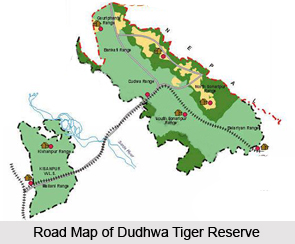 This Tiger reserve is highly acclaimed over the years. In order to take a glance of the mighty tigers, the tourists in large number throng the place. Dudhwa Tiger Reserve is located in the Lakhimpur-Kheri district of Uttar Pradesh. It was densely covered with tall grasses make it easier for the tigers to remain hidden. Under the patronage of nature lover Billy Arjan Singh, the Dudhwa Tiger reserve was being saved to face any kind of destruction due to pollutants and animal killers. However the dense grass cover the region making tiger difficult from sight seeing. However, this is the park where Billy Arjan Singh successfully weaned the tiger cub, Tara, and successfully helps her to get accustomed to the beautiful life in the wild sanctuary. In the year 1965, it assumed the status of wildlife sanctuary. Afterwards it got upgraded to the status of a national park in the year 1977. Dudhwa became part of a Project Tiger reserve in the late 1980s.
Sal forest region and also moisture laden grass fields embellish the Dudhwa Tiger Reserve. In certain places the grass rise to a great height, so much so, that it can hide a full bodied elephant.
This Tiger reserve is highly acclaimed over the years. In order to take a glance of the mighty tigers, the tourists in large number throng the place. Dudhwa Tiger Reserve is located in the Lakhimpur-Kheri district of Uttar Pradesh. It was densely covered with tall grasses make it easier for the tigers to remain hidden. Under the patronage of nature lover Billy Arjan Singh, the Dudhwa Tiger reserve was being saved to face any kind of destruction due to pollutants and animal killers. However the dense grass cover the region making tiger difficult from sight seeing. However, this is the park where Billy Arjan Singh successfully weaned the tiger cub, Tara, and successfully helps her to get accustomed to the beautiful life in the wild sanctuary. In the year 1965, it assumed the status of wildlife sanctuary. Afterwards it got upgraded to the status of a national park in the year 1977. Dudhwa became part of a Project Tiger reserve in the late 1980s.
Sal forest region and also moisture laden grass fields embellish the Dudhwa Tiger Reserve. In certain places the grass rise to a great height, so much so, that it can hide a full bodied elephant.
Thanks to the marvelous efforts of the administrative officials and controlling bodies a radical drop in its population was being prevented from further fall. In fact it has become a heavenly abode of some rare wild species. The rare Swamp Deer (Barasingha) that can only be found in India has a wide population of 1,800, with in the park locale. They are widely seen in the grassy wetlands of Sathiana and Kakmha, where they kept on grazing in the morning and again in the evening.
The One-horned Rhinoceros, widely known for its calm nature, faced almost extinction from the terrain plains of Uttar Pradesh and throughout the Gangetic plains. It happened in the late years of nineteenth century. Later, the Assam and West Bengal populations of this specie l were severely endangered by serious disease and poachers. As a timely initiative in the year 1985, two male and five female rhinos were shifted to Dudhwa. Ultimately by the year 2001, it got proliferated to sixteen.
 During the middle year of 60s and early 70s, a small flock of wild elephants was seen here. The mysterious Hispid Hare, which was last seen in the year 1951 and thought to be almost on the verge of extinction, was seen once again in 1984. It was a common scene where the Muggers, better known as Marsh Crocodiles and otters are seen lying on the sandy river banks of Mohana and Suheli rivers.
During the middle year of 60s and early 70s, a small flock of wild elephants was seen here. The mysterious Hispid Hare, which was last seen in the year 1951 and thought to be almost on the verge of extinction, was seen once again in 1984. It was a common scene where the Muggers, better known as Marsh Crocodiles and otters are seen lying on the sandy river banks of Mohana and Suheli rivers.
The lakes, grasslands, riverine valleys and dense forestlands etc creates Dudhwa Tiger Reserve, the ideal breeding ground of numerous birds. More than four hundred species of birds are available. These include Black Francolin, Swamp Francolin, Red Junglefowl, Indian Peafowl, Oriental Pied Hornbill, Blue-bearded Bee-eater, Great Slaty Woodpecker, Greater Flameback, Streak-throated Woodpecker, Lineated Barbet, Drongo Cuckoo, Green-billed Malkoha, Striated Babbler, Yellow-bellied Prinia, Straited Grassbird and Bristled Grassbird. Even endangered species are found here. Among them the Bengal Florican, is significant. It is one of the rare wading birds in India and also in the whole world today. Numerous migratory birds like duck; geese are seen near water bodies. Other water-bred birds are namely Black-necked Stork, Black Stork, Lesser Adjutant, White Stork, Sarus Crane, Brown Crake and River Lapwing, River Tern, Cinnamon Bittern, Black Bittern, Stork-billed Kingfisher in the wetlands. Among carnivorous bird species that are found in Dudhwa Tiger Reserve, birds like eagles, harriers, hawks, Pallas`s Fish Eagle, Lesser Fish Eagle. Crested Serpent Eagle, Crested Goshawk, Eurasian Marsh Harrier, Hen Harrier, Brown Fish Owl deserve special mentioning. In the reserve, a mélange of owls dominate wild life since dawn to dusk and dusk to dawn. During this time also, wide varieties of mammalian species too are found in various corners of the reserve. Tiger, Swamp Deer (Barasingha), Hog-deer, Leopard, Leopard-cat, Fishing Cat, Jungle Cat, Common Palm Civet etc are some of them. Smooth Indian Otter, Sloth Bear, Sambar, Barking Deer, Spotted Deer (Chital) These wild animals of the Dudhwa Tiger Reserve have still existed in spite of various onslaughts, mostly brought about the human society.
The Dudhwa Tiger Reserve is playing a pivotal role in preserving animals and birds in the midst of their natural habitat of wild life.



















